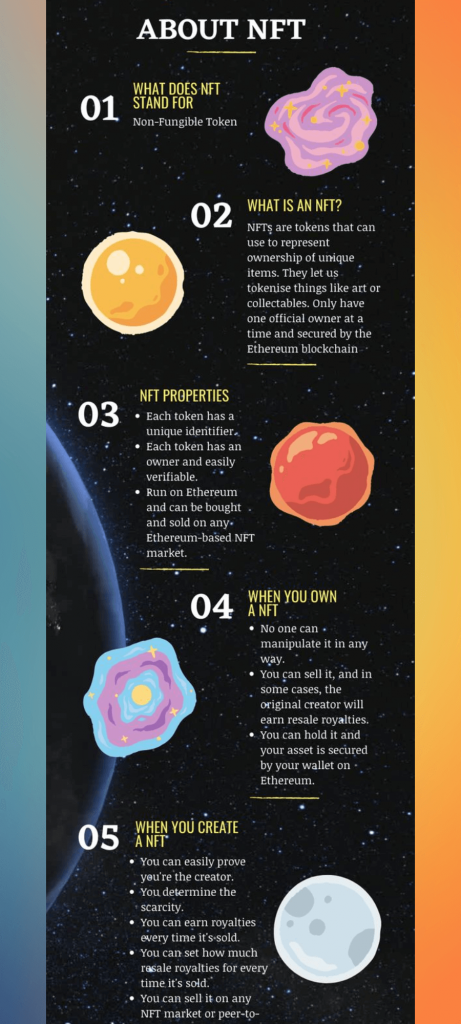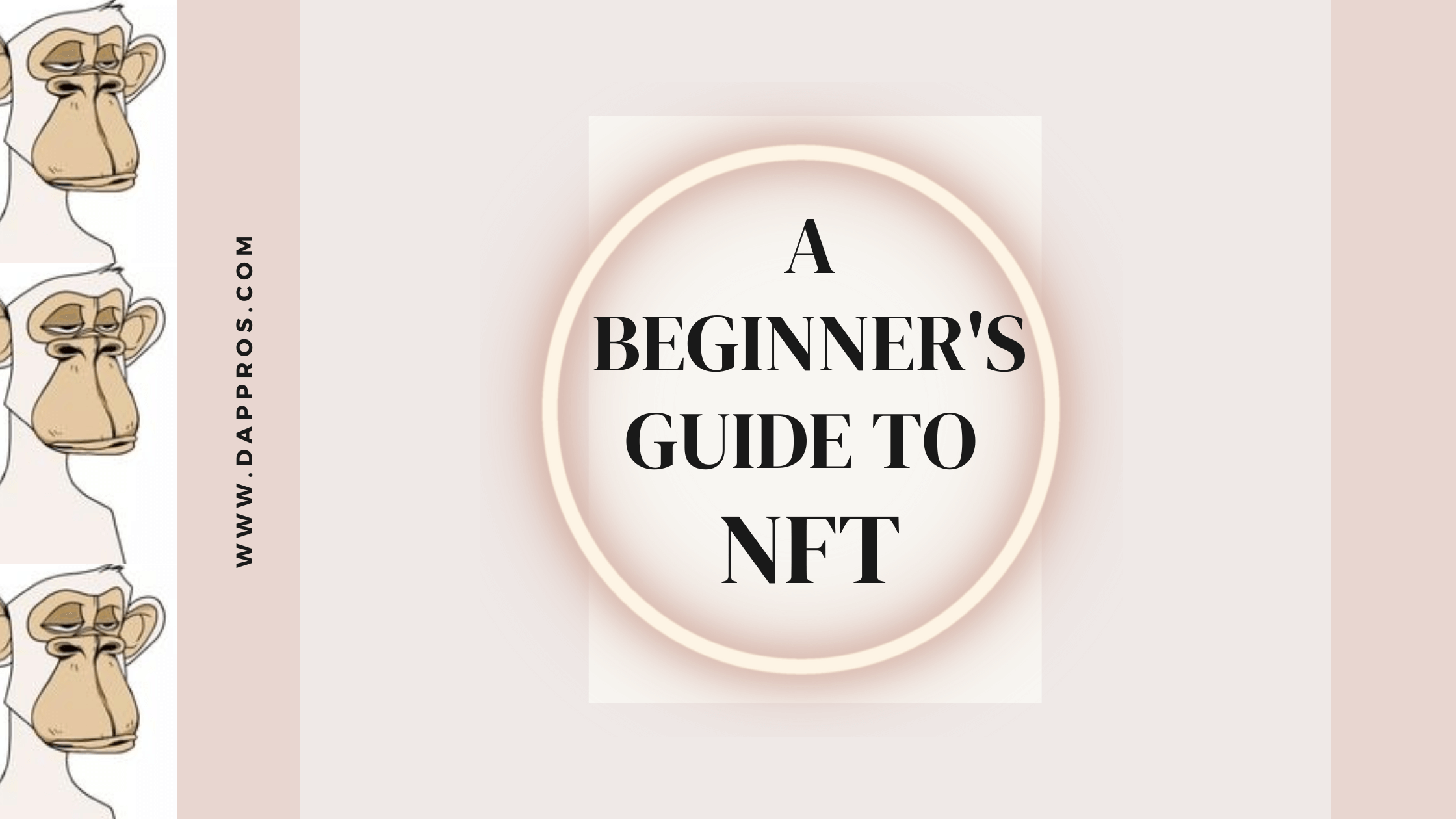Discover all you need to know to begin collecting, minting and selling non-fungible tokens (NFTs). NFTs are transforming the worlds of gaming, art, and collectibles by altering the way we manage unique assets in digital form. In this beginner’s guide to NFT investing you’ll learn all, you need to know to start collecting, minting and selling NFTs.

Pic Credit Bitwewe Exchange
What exactly are NFTs?
Non-fungible tokens, or NFTs, are smart contracts that reflect ownership of one-of-a-kind goods (digital art, videos, music, tickets to an event, legal documents, etc.)
When something is described as “non-fungible,” it simply implies that it is unique and cannot be replaced with another. A $1 bill, for example, is a fungible object since one dollar note may be substituted by another and be viewed and valued the same. Outside crypto, “non-fungible” assets include diamonds, land, and even baseball cards. Because of its unique features, a non-fungible thing cannot interchange with other items.
To ensure that there is only one genuine owner of an NFT, the transaction and contract are recorded and secured on the Ethereum blockchain.
How do NFTs work?
When an NFT is generated or “minted,” a smart contract is established and stored on the blockchain. This contract is handled by a unique (or address) that identifies the current owner. When you buy an NFT (imagine digital art), your notable ID changes and is recorded on the blockchain (an online public ledger). Through the Ethereum blockchain, you now have public and traceable ownership of that item.
One individual may only own an NFT, and the sale, price, and ownership are all recorded on a public ledger (blockchain). When the NFT changes hands, the blockchain acknowledges the transaction, which is visible to everyone.
Said, you own the NFT, and establishing ownership is straightforward and safe, as is any subsequent asset sale.
What Is the Purpose of NFTs?
Artists may directly monetise their material thanks to blockchain technology and NFTs. Artists and musicians no longer depend on galleries and online marketplaces to sell their works. As NFTs, they may offer their content directly to customers without paying these third-party middlemen.
Content makers may also build royalties, so the creator earns a share of all sales anytime the NFT is resold. This feature cannot change after it has been introduced since it is encoded into the asset itself. It is especially appealing to many artists since many do not presently have future earnings beyond the first sale of their material.
What are the applications of NFTs?
Because NFTs are one-of-a-kind, they may use them to value and verify digital assets such as virtual land parcels, artwork, etc. The entertainment business is one of the most critical industries for NFTs.
Examine how NFTs are being utilised to generate products in the following industries:
CryptoArt is classified into two kinds. The phrase mainly refers to cryptocurrency-themed works incorporating blockchain into their cultural, political, economic, or philosophical themes. However, CryptoArt may also refer to digital artworks directly published to the blockchain as NFTs. Beeple and FEWOCIOUS are two of the most prominent CryptoArtists right now.
Musicians are utilising NFTs to add unique material to newly issued and re-released albums. Kings of Leon released a tiered edition of their 2021 album When You See Yourself, providing fans lifetime access to front-row seats. DJ 3LAU transformed unreleased recordings, re-recorded songs, and album artwork into NFTs while re-releasing his album, Ultraviolet. Portugal, This Man, Akon, Eminem, DJ Steve Aoki, and Shawn Mendes are other musicians active in the NFT space.
Sports – Major league teams in American football, basketball, and hockey have generated digital memorabilia for their fans in the form of one-time films. In addition, the sports card maker Topps has created NFT packs, including rare cards e-signed by prominent players.
Video game – Developers use NFTs to enable gamers to build and own customised game skins. Players in various games (such as Alien Worlds, Mist, and Minecraft) may earn NFTs, which can subsequently be exchanged for bitcoin.
Collectables – Pokémon, Magic: The Gathering and Marvel are just a few brands that provide NFT collectables to their fans.
What are the most effective strategies to profit from NFTs?
If you want to generate money using NFTs, there are several methods to do it. The following are some effective methods:
1. Play-to-Earn games: These new games allow you to own the assets you earn or unlock in the game. These NFTs may be collected and sold in-game or on a marketplace.
2. Collecting: Many individuals gather NFTs by identifying new projects and ‘HODLing’ them until their prices rise (they can also decrease).
3. NFTS Flipping: We wouldn’t suggest it. However, some individuals prefer to acquire NFTs to sell them at a more excellent price later. It’s dangerous.
4. Investing in new NFTs: If you’re serious about going into NFTs, look for projects that interest you and get in early. You may often get on the ‘whitelist’ by participating in the Discord community.
5. Make your NFT: the success of NFTs is that anybody with a computer can make one, and even an NFT collection can support another project. NFTs may now be generated for free, albeit there are certain constraints.
Popular NFT Marketplaces
OpenSea.io: Advertises itself as a platform to purchase “unique digital artefacts and collectables” from other users. To that end, initiate action. To access NFT collections, just register. Discovering new music may be as simple as sorting by sales volume.
Rarible: Similar to OpenSea, Rarible is a decentralised, public trading platform where creators may freely issue and trade NFTs. Voting rights for platform elements like fees and community rules are delegated to holders of RARI tokens.
Foundation: To post their work, artists need “upvotes” from other users or an invitation from the site’s administrators. The community’s art may be better quality because of its exclusive membership and costly entrance charge (artists must also pay “gas” to mint NFTs). For instance, Chris Torres (Nyan Cat’s creator) used the Foundation platform to sell the NFT. Price increases are possible if interest in NFTs remains strong or even increases, which may be good news for artists and collectors.
While hundreds of NFT artists and collectors may be found on these sites, it is still essential to do thorough research before making any purchases. There have been cases of artists being tricked by impostors who have promoted and sold their work without permission.
Furthermore, the verification methods for creators and NFT listings differ among platforms, with some being more strict than others. For NFT postings, OpenSea and Rarible, for example, do not need owner verification. Buyer safeguards seem to be limited at best. Therefore while buying NFTs, remember the ancient adage “caveat emptor” (let the buyer beware).
Some well-known instances of NFTs
While there are many different types of non-fungible tokens, digital horse racing is one of the most intriguing applications for this technology.
Zed Run is a digital horse racing platform that hosts races 24 hours a day, seven days a week.
The “horses” on the Zed Run platform exist as NFTs that only serve as digital assets. These NFT horses were created by the Australian-based Virtually Human Studio and are available on the Ethereum network as ERC-721 coins. What distinguishes digital horses from other types of NFTs is that each horse is regarded as a unique “breathing NFT.”
Each horse has its lineage that can be tracked on the blockchain and may mate with other horses to create new horses. Every horse may race (their racing history is recorded on the blockchain) and has characteristics that can be passed down to their children.
Axie Infinity has swiftly become one of the most popular DeFi NFT ecosystems and games. In terms of active players, it is the most popular Ethereum game. On their in-house marketplace, 250,000+ active daily participants and 90,000+ ETH transacted. It is a Pokémon-inspired game in which players combat one other, obtain goods, raise new “Axies,” and build kingdoms for their pets. Axies are digital animals generated in the NFT format. Players may exchange the axis tokens to “gather them all.” There are over 500 distinct types of bodily components and over 500 different types of axies. Axies may fight each other for experience points, which can use to level up the axle or develop its bodily parts. Owners may also breed axies to keep or sell on the Axie marketplace.
Wrapping Up
Many NFT applications are now centered on the entertainment sector and popular culture. We’ve already seen how they’ve been marketed by sports teams, video game and film companies, and performers. They do, however, have the potential to completely change the realms of copyright, intellectual property and software licensing.
Remember that an NFT’s worth ultimately depends on what someone else is willing to pay. Demand, not fundamental, technical, or economic variables, often affects stock prices and, at best, forms the basis of investor demand, thus determining the price. We hope you loved reading our beginner’s guide to NFT investing. If you have any queries, please drop your questions in the comment section below.


